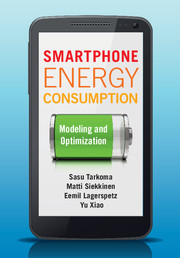Book contents
- Frontmatter
- Contents
- Preface
- List of abbreviations
- Part I Understanding energy consumption
- 1 Introduction
- 2 Energy and power primer
- 3 Smartphone batteries
- 4 Energy measurement
- 5 On human behavior and energy efficiency
- Part II Energy management and conservation
- Part III Advanced energy optimization
- Appendix A An energy profile application
- Index
- References
1 - Introduction
from Part I - Understanding energy consumption
Published online by Cambridge University Press: 05 August 2014
- Frontmatter
- Contents
- Preface
- List of abbreviations
- Part I Understanding energy consumption
- 1 Introduction
- 2 Energy and power primer
- 3 Smartphone batteries
- 4 Energy measurement
- 5 On human behavior and energy efficiency
- Part II Energy management and conservation
- Part III Advanced energy optimization
- Appendix A An energy profile application
- Index
- References
Summary
The last ten years has been the era of personal and social communications, with the rapid proliferation of smartphones that provide always-on connectivity with people and information. The mobile computing environment has changed over the years in many ways. Today's devices are powerful computers and sensing systems that have versatile communications capabilities, and they are capable of running native and web browser-based applications that can tap into system resources such as various onboard sensors. The devices also come in many forms and shapes, such as small and large form-factor phones, tablets, and wristwatches.
Understanding smartphone and mobile device energy consumption is a vital and challenging problem. It is vital, because the remaining operating time of a device should be understood and maximized when necessary. It is challenging, because a device consists of various hardware and software systems that work together. Various modeling, prediction, and optimization techniques are needed to engineer energy-efficient mobile systems.
Overview and the environment
Energy efficiency in mobile computing, especially in the wireless data transmission involved in mobile applications, is one of the challenges that has attracted much attention from mobile device manufacturers, application providers, and network operators. Compared with traditional telephone services, such as voice calls and short message service, executing modern mobile applications consumes much more computing and networking resources and therefore demands much more energy. However, battery technology has not developed as fast as mobile computing technology and has not been able to satisfy the increasing energy demand. This has directly resulted in a dramatic decrease in battery life, that is, the time until the next charge.
- Type
- Chapter
- Information
- Smartphone Energy ConsumptionModeling and Optimization, pp. 3 - 22Publisher: Cambridge University PressPrint publication year: 2014
References
- 2
- Cited by



